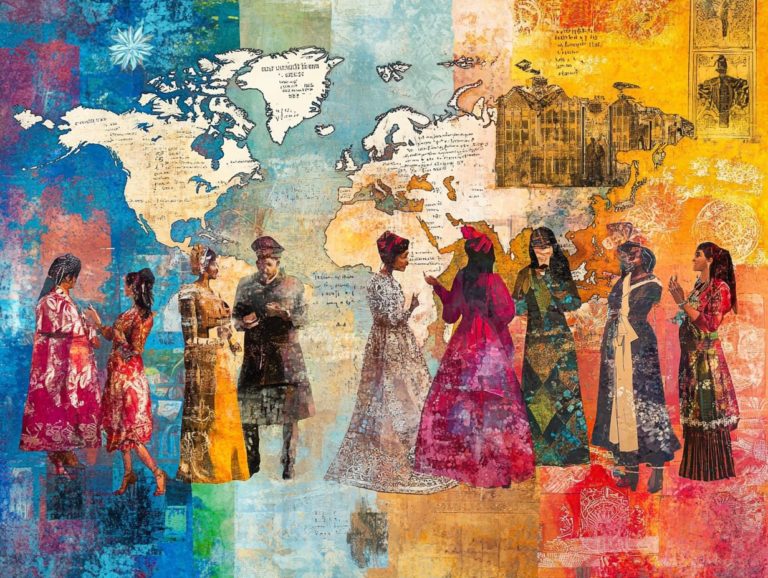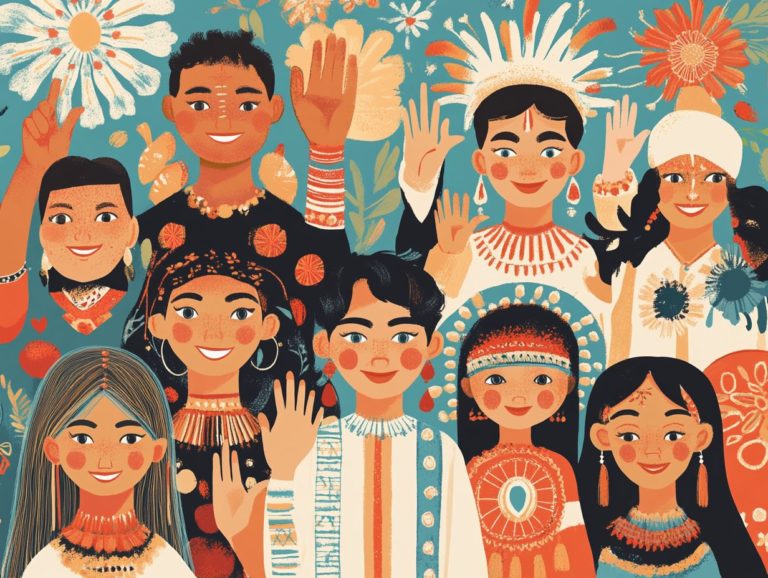the role of technology in bridging cultural gaps
In today s interconnected world, grasping and navigating cultural differences is crucial.
Bridging these cultural gaps enhances communication skills, fosters collaboration, and promotes mutual respect among diverse communities. However, challenges often arise from communication barriers and misunderstandings.
Fortunately, advancements in technology provide powerful tools to help overcome these hurdles. This article explores the importance of bridging cultural divides, the impact of technology, and offers practical tips and success stories to guide you on your journey toward greater cultural understanding.
Contents
- Key Takeaways:
- The Importance of Bridging Cultural Gaps
- Challenges in Bridging Cultural Gaps
- The Role of Technology in Bridging Cultural Gaps
- Examples of Successful Cultural Exchange Through Technology
- Tips for Using Technology to Bridge Cultural Gaps
- Frequently Asked Questions
- 1. What is the role of technology in bridging cultural gaps?
- 2. How does technology facilitate cultural understanding?
- 3. Can technology help overcome language barriers?
- 4. What role does social media play in bridging cultural gaps?
- 5. How can virtual reality technology contribute to bridging cultural gaps?
- 6. Is technology the only solution for bridging cultural gaps?
Key Takeaways:

Technology has significantly bridged cultural gaps by creating opportunities for communication and understanding among different backgrounds. Advancements like video conferencing and social media ease connections with individuals from various cultures, fostering relationship-building. Virtual exchange programs successfully promote cultural exchange, providing platforms for interaction and learning from diverse perspectives.
The Importance of Bridging Cultural Gaps
Bridging cultural gaps is vital for improving teamwork within global teams and cultivating a diverse workforce that enhances the employee experience.
This process involves recognizing and understanding diverse communication styles, cultural backgrounds, and business practices that influence interactions in our world.
Prioritizing cultural awareness and sensitivity training boosts employee engagement and fosters a more inclusive work environment that truly values cultural diversity.
Understanding Cultural Differences
Understanding cultural differences helps you manage global teams effectively and enhances your ability to collaborate and resolve conflicts.
For instance, in a diverse team, a direct communication style common in Western cultures may clash with a more nuanced, indirect approach often preferred in many Asian cultures. Navigating these disparities carefully is crucial to avoid misunderstandings.
Organizations that prioritize intercultural training witness significant improvements in team dynamics and employee satisfaction. Teams that embrace cultural diversity are often more innovative, as shown by global tech firms that leverage a variety of perspectives for successful product development.
Challenges in Bridging Cultural Gaps
Bridging cultural gaps presents challenges, including communication barriers, differing cultural norms, and the digital divide, all of which can impede effective collaboration.
Barriers to Communication and Understanding

Communication barriers can hinder understanding and collaboration within diverse teams, arising from differing cultural practices and norms. Factors such as language differences, non-verbal cues, and varying interpretations of feedback contribute to these obstacles.
When you and your colleagues lack a shared understanding, misunderstandings, frustration, and reduced engagement can follow.
Organizations can implement cultural sensitivity training to enhance awareness of diverse perspectives and promote an inclusive atmosphere.
Integrating collaboration tools that support real-time translation facilitates clear communication, allowing team members to connect more effectively, regardless of background.
The Role of Technology in Bridging Cultural Gaps
Technology serves as a crucial bridge in closing cultural divides, providing innovative solutions like AI-driven tools, collaboration platforms, and virtual reality.
These advancements enhance cross-cultural interactions and elevate employee engagement, creating a more cohesive and inclusive environment.
Don’t miss out on the opportunity to apply these insights in your organization. Share your experiences with cultural understanding!
Advancements in Communication Technology
Recent advancements in communication technology, particularly in AI capabilities and video conferencing tools, have revolutionized how teams collaborate and manage projects globally.
These innovations dismantle cultural barriers that often obstruct collaboration in diverse workforces. Real-time translation features enable effortless communication, regardless of the languages spoken by team members.
The introduction of personalized recommendations and instant feedback mechanisms cultivates a more inclusive environment. Colleagues feel valued and engaged in their roles.
By leveraging these tools, organizations can enhance the employee experience while fostering a culture of continuous improvement. This promotes better teamwork and drives overall productivity to new heights.
Virtual Exchange Programs
Virtual exchange programs are exceptional avenues for promoting cultural diversity. They offer immersive experiences that foster understanding between different cultures.
These initiatives connect individuals globally, using technology to dismantle geographical barriers and cultivate meaningful interactions.
As a participant, you engage in collaborative projects, discussions, and mentorship opportunities, often resulting in lasting professional relationships.
Let s look at an amazing success story where a virtual exchange linked a team in the United States with one in India. Through this collaboration, employees enhanced their engagement and satisfaction while gaining invaluable insights into diverse working styles and cultural perspectives.
Such exchanges highlight the significance of cultural awareness in today s globalized workplace, ultimately enriching the professional environment.
Examples of Successful Cultural Exchange Through Technology

Numerous case studies showcase the transformative power of technology in facilitating successful cultural exchange.
They reveal how organizations have enhanced employee experiences and fostered collaboration among their global teams.
Case Studies and Success Stories
Analyzing case studies offers invaluable insights into effective cultural exchange initiatives. These can significantly enhance employee engagement and collaboration.
For instance, a prominent multinational tech company rolled out a cultural exchange program, enabling employees from diverse backgrounds to shadow their counterparts in various countries. Through weekly workshops and informal gatherings, they cultivated a deeper understanding of each other s cultural perspectives.
This initiative boosted communication and teamwork across borders. Employees felt more satisfied with their jobs and enjoyed a more inclusive work environment, illustrating how well-designed cultural programs can lead to remarkable improvements in overall employee experience and productivity.
Tips for Using Technology to Bridge Cultural Gaps
Effectively harnessing technology to bridge cultural gaps requires a thoughtful approach to implementing best practices. This enhances communication and nurtures understanding among diverse teams.
Best Practices for Effective Communication and Understanding
Implementing best practices for effective communication is crucial for fostering understanding and collaboration among diverse teams. By recognizing the unique perspectives each team member brings, an inclusive atmosphere can be cultivated that encourages open dialogue.
Prioritizing cultural sensitivity training equips team members with the knowledge needed to navigate various cultural nuances and sidestep miscommunication. Incorporating engagement strategies, such as regular cross-cultural workshops and team-building activities, enhances interpersonal relationships and builds trust.
These initiatives facilitate smoother interactions and foster a sense of belonging. Teams can operate more harmoniously, ultimately driving collective success.
Frequently Asked Questions

1. What is the role of technology in bridging cultural gaps?
Technology plays a crucial role in helping people connect across different cultures. It allows individuals to share ideas and learn from each other’s perspectives.
2. How does technology facilitate cultural understanding?
Technology helps people access information about various cultures, customs, and traditions. This promotes cultural understanding and appreciation.
3. Can technology help overcome language barriers?
Yes, technology provides tools like translation apps and software. These resources make it easier to talk and communicate between people from different cultures.
Social media platforms connect people from various cultures. They break down cultural barriers and promote cross-cultural understanding.
5. How can virtual reality technology contribute to bridging cultural gaps?
Virtual reality creates a simulated environment, allowing individuals to experience different cultures in an immersive way. This helps them appreciate and understand other cultures deeply.
6. Is technology the only solution for bridging cultural gaps?
No, while technology significantly helps, it’s not the only solution. Face-to-face interactions, cultural exchange programs, and education are also crucial for promoting cross-cultural understanding and acceptance.




